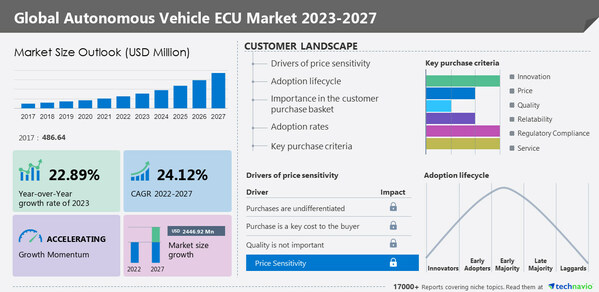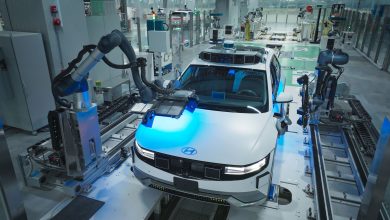Technavio: Autonomous vehicle ECU market to grow at a CAGR of 24.12%

The global autonomous vehicle ECU market size is estimated to increase by USD 2,446.92 million between 2022 and 2027. The market’s growth momentum will accelerate at a CAGR of 24.12%. The report also includes historic market data from 2017 to 2021. In 2017, the autonomous vehicle ECU market was valued at USD 486.64 million. COVID-19 had the most negative impact on the global automotive industry in recent years, resulting in a steep fall in demand and a large-scale disruption of the supply chain. It has exerted intense pressure on an already-stressed global automotive market. Yet, there are high predictions that few countries are bringing manufacturing facilities and production back on track, indicating that the supply side is on a restoration line.
Key trends – The growing popularity of semi-autonomous trucks is a key trend in the market. The demand for truck platooning systems is increasing among industrialized nations, which has fueled the demand for semi-autonomous trucks. Truck platooning requires the installation of high-end, specialized platooning algorithms that incorporate sensor fusion of radar, LiDAR, and cameras in vehicles as well as platooning systems that install ADAS. The vehicles automatically synchronize speed and braking actions, which increases fuel efficiency and improves traffic congestion control. Thus, the growing demand for truck platooning by large fleet operators in developed economies is expected to fuel the adoption of semi-autonomous trucks during the forecast period, which, in turn, will support market growth.
Autonomous vehicle ECU market – Customer landscape
To help companies evaluate and develop growth strategies, the report outlines –
- Key purchase criteria
- Adoption rates
- Adoption lifecycle
- Drivers of price sensitivity
Autonomous vehicle ECU market – Vendor analysis
Vendor landscape –
The global autonomous vehicle ECU market is fragmented, with the presence of several global as well as regional vendors. A few prominent vendors that offer autonomous vehicle ECU in the market are Aptiv PLC, Autoliv Inc., Continental AG, DENSO Corp., Hitachi Ltd., Hyundai Motor Group, Infineon Technologies AG, Intel Corp., Johnson Controls International Plc., Magna International Inc., Marelli Holdings Co. Ltd., Mitsubishi Electric Corp., NVIDIA Corp., NXP Semiconductors NV, Panasonic Holdings Corp., Renesas Electronics Corp., Robert Bosch GmbH, Stellantis NV, Texas Instruments Inc., and ZF Friedrichshafen AG and others.
Autonomous vehicle manufacturers are focusing on developing technologically advanced vehicles. The development of autonomous features and smart road infrastructure will provide immense growth opportunities for the growth of the global autonomous vehicle ECU market. Vendors compete on the basis of contracts won, product and aftermarket service quality, reliability, and cost. To survive and prosper in a competitive business atmosphere, it is crucial for vendors to offer autonomous vehicles that feature latest technologies. Hence, the competition among the vendors is expected to intensify during the forecast period.
Vendor offerings –
- Aptiv PLC – The company offers autonomous vehicle ECU such as Aptiv Smart Vehicle Architecture.
- Autoliv Inc. – The company offers autonomous vehicle ECU under the brand Veoneer.
- Continental AG – The company offers autonomous vehicle ECU such as Airbag Control Unit Premium.
- DENSO Corp. – The company offers autonomous vehicle ECU such as Automated Driving Extension Electronic Control Unit.
Autonomous vehicle ECU market – Segmentation assessment
Segment overview
Technavio has segmented the market based on Application (Semi-autonomous and Autonomous) and Geography (North America, Europe, APAC, South America, and Middle East and Africa).
- The passenger car segment will account for a significant share of the market’s growth during the forecast period. Automakers are focusing on developing autonomous technology for passenger cars, with the rise in demand for autonomous vehicles from ride-hailing and logistics companies. Such factors will drive the segment growth during the forecast period.
Geography overview
Based on geography, the global autonomous vehicle ECU market is segmented into North America, Europe, APAC, South America, and Middle East and Africa. The report provides actionable insights and estimates the contribution of all regions to the growth of the global autonomous vehicle ECU market.
- North America is estimated to account for 46% of the growth of the global market during the forecast period. The US, Canada, and Mexico are the key countries in the market. Many prominent vehicle manufacturers are moving their manufacturing facilities to Mexico owing to labor arbitrage and low production costs. This has increased vehicle production in the country and, in turn, the demand for autonomous technologies. Such factors will drive market growth during the forecast period.
Autonomous vehicle ECU market – Market dynamics
Leading drivers – The rising number of accidents due to human errors is driving the global autonomous vehicle ECU market growth. Driver error is the main cause of accidents. These accidents can be prevented by encouraging drivers to take precautions and incorporating numerous technologies in vehicles, such as active safety systems. Hence, the automotive ecosystem will gradually shift to autonomous vehicles that are free from human errors. These factors will fuel the market growth during the forecast period.
Major challenges – The high cost associated with semi-autonomous and autonomous technologies is challenging the global autonomous vehicle ECU market growth. The use of ADAS technologies and systems, including radars, cameras, sensors, and delicate and sophisticated image analysis algorithms, is limited to luxury automobiles due to their high costs and maintenance. For instance, ACC is rarely offered in low-cost vehicles, as it costs more than USD 1,500. Similarly, night vision cameras comprise various sensors, such as uncooled microbolometer sensors, which are highly expensive. Such factors will challenge the growth of the market during the forecast period.



